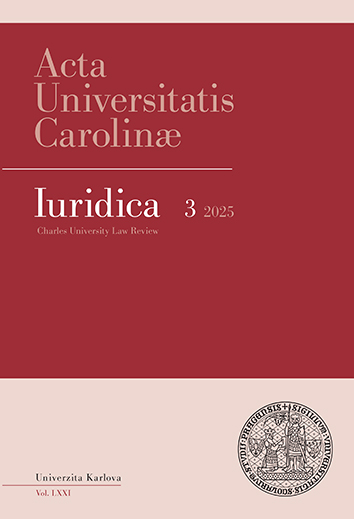Acta Universitatis Carolinae Iuridica (dále jen AUCI) je hlavním časopisem Právnické fakulty UK. Vychází od roku 1954, patří tak mezi tradiční právnické časopisy teoretického zaměření.
Jako obecný právnický časopis přináší delší studie i kratší články o jakýchkoli relevantních otázkách v právní teorii i mezinárodním, evropském a vnitrostátním právu. AUCI také publikuje materiály vztahující se k aktuálním otázkám legislativy. AUCI je recenzovaný časopis a přijímá příspěvky od českých i zahraničních autorů. Příspěvky zahraničních autorů jsou zveřejňovány v původním jazyku – slovenštině, angličtině, němčině, francouzštině.
AUCI je teoretický časopis pro otázky státu a práva. Jeho vydavatelem je Univerzita Karlova v Praze, Právnická fakulta, prostřednictvím nakladatelství Karolinum. Vychází čtyřikrát ročně, termíny vydání časopisu naleznete zde.
Články uveřejněné v časopise AUCI procházejí nezávislým recenzním řízením (peer review), které je oboustranně anonymní. Posuzovatelé z daného oboru vyjadřují své stanovisko k vědecké kvalitě příspěvku a vhodnosti publikace v časopisu. V případě připomínek je stanovisko zasíláno zpět autorovi s možností přepracování textu (blíže viz Pokyny pro autory – Průběh recenzního řízení).
Časopis AUCI (ISSN 0323-0619) je evidován v České národní bibliografii (vedena Národní knihovnou ČR) a v Index to Foreign Legal Periodicals (veden American Association of Law Libraries). AUCI má přiděleno evidenční číslo periodického tisku e. č. MK E 18585.
V r. 2021 byl jako první časopis Právnické fakulty Univerzity Karlovy zařazen do prestižní mezinárodní databáze Scopus. Tato databáze společnosti Elsevier je největší abstraktovou a citační databází recenzované literatury na světě. Od zařazení do elitní databáze Scopus si redakce časopisu slibuje nejen zvýšení čtenosti časopisu, ale také nárůst zájmu o publikaci příspěvků jak českých, tak zahraničních autorů.
AUCI je tzv. časopisem otevřeným a veškerý jeho obsah je zveřejňován jak na webu fakulty, tak na webových stránkách nakladatelství Karolinum. Přístup k němu je bezplatný. Domovská stránka časopisu AUCI je na webových stránkách Nakladatelství Karolinum.
Časopis AUCI využívá licenci Creative Commons: CC BY 4.0.
Dlouhodobou archivaci digitálního obsahu časopisu zajišťuje Portico.
AUC IURIDICA, Vol 44 No 3 (1998), 59–72
Mezinárodní ochrana práv dítěte
[The International Protection of the Rights of the Child]
Harald Christian Scheu
DOI: https://doi.org/10.14712/23366478.2025.266
zveřejněno: 31. 03. 2020
Abstract
The adoption of the UN-Convention on the rights of the child was regarded a great success after a series of complicated negotiations. The Convention broke records in the field of international human rights protection. No other convention was signed and ratified by so many states and never before has a convention on the protection of human rights entered into farce so quickly. The draft Convention was adopted by the UN General Assembly on 20 November 1989, already on 26 January 1990 the Convention entered in to farce after the 60th State Party had submitted its ratification. After a detailed analysis it can’t be ignored that the Convention is at times a very weak compromise between conflicting interests. The Convention contains many promises and programmatic declarations, but offers very few answers to concrete questions. As for the implementation of the Convention into the legal order of the state party there remains a large scope for interpretation. The control mechanism provided by the Convention is a very weak one. The signatories are obliged to submit reports containing information about their efforts to implement the Convention. Then reports are examined by the UN Committee on the rights of the child. The Committee can address some recommendations to the governments of the states. It is evident that the ideas and aims of the authors of the Convention were not concrete enough to reach an effective solution. The same Jack of precision can be found in ·the European Convention on the Exercise of Children’s Rights (CECR) which was presented by the Council of Europe on 25 January 1995. The CECR intends to complement the UN convention. The CECR focuses on aspects of procedure in family matters before the Court and the administrative authorities. The mechanism of the CECR is rather weak, since the State Parties can specify, for which matters they will apply the commitments of the CECR. It can be said that the UN Convention on the rights of the child and the CECR are only the first step towards a general improvement of the children s legal position. The work of the UN Committee on the rights of the child is important for the development, but the success of the recommendations depends on the cooperation of the signatories. Same of them have shown little readiness to allow interventions into what they consider their sphere of sovereignty. Therefore the above mentioned legal documents do not bring a definitive solution to the problems linked with the situation of children in our world. It will be necessary to improve the international standard of children protection by more effective means. Children s rights are a very difficult question in the tension between the interests of child, the interests of the parents and the interests of the State. Solutions have to respect the special needs of children and they have to be more precise.

Mezinárodní ochrana práv dítěte is licensed under a Creative Commons Attribution 4.0 International License.
230 x 157 mm
vychází: 4 x ročně
cena tištěného čísla: 65 Kč
ISSN: 0323-0619
E-ISSN: 2336-6478
